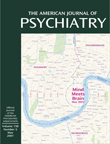Mirtazapine for Neuroleptic-Induced Akathisia
Mr. A was a 28-year-old unmarried man who came in for treatment after a 3-month history of persecutory delusions, auditory hallucinations, and bizarre behavior. He had no previous or family history of psychiatric illness or drug abuse. The results of a neurological evaluation, EEG, routine blood and urine tests, serum electrolyte measurements, and urea, liver, and thyroid function tests were within normal limits. A DSM-IV diagnosis of schizophreniform disorder was established, and treatment with haloperidol, 10 mg/day, was initiated. Four days later, Mr. A complained of leg restlessness, an inability to sit still, and a constant urge to move. His global score on the Barnes Akathisia Scale was 4 (“marked akathisia”). Administration of biperiden (4 mg b.i.d. for 5 days) with the subsequent addition of diazepam (10 mg/day for 3 days) had no effect on the severity of his neuroleptic-induced akathisia.Mr. A consented to the addition of mirtazapine (15 mg at 8:00 a.m. for 5 days). Substantial relief of the subjective component of the akathisia, accompanied by a disappearance of the akathitic movements, was noted on the second day of mirtazapine treatment. Mr. A’s score on the Barnes Akathisia Scale dropped to 1. Discontinuation of mirtazapine on the fifth day led to a partial recurrence of the akathisia (Barnes Akathisia Scale score: 3), but a rechallenge (for 7 days) completely ameliorated his symptoms (Barnes Akathisia Scale score: 0). Mild transient sedation was the only side effect.
References
Information & Authors
Information
Published In
History
Authors
Metrics & Citations
Metrics
Citations
Export Citations
If you have the appropriate software installed, you can download article citation data to the citation manager of your choice. Simply select your manager software from the list below and click Download.
For more information or tips please see 'Downloading to a citation manager' in the Help menu.
There are no citations for this item
View Options
View options
PDF/ePub
View PDF/ePubGet Access
Login options
Already a subscriber? Access your subscription through your login credentials or your institution for full access to this article.
Personal login Institutional Login Open Athens loginNot a subscriber?
PsychiatryOnline subscription options offer access to the DSM-5-TR® library, books, journals, CME, and patient resources. This all-in-one virtual library provides psychiatrists and mental health professionals with key resources for diagnosis, treatment, research, and professional development.
Need more help? PsychiatryOnline Customer Service may be reached by emailing [email protected] or by calling 800-368-5777 (in the U.S.) or 703-907-7322 (outside the U.S.).

